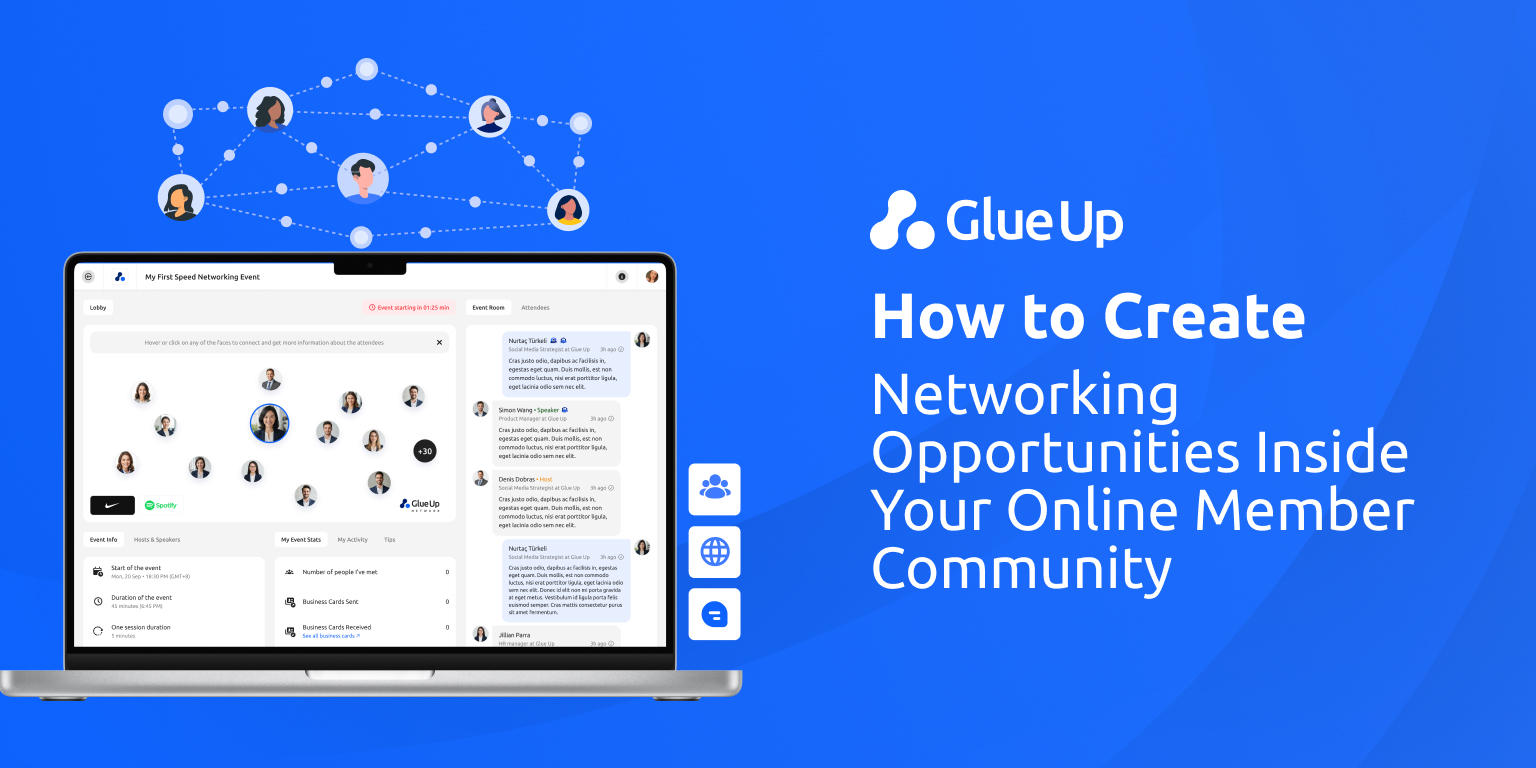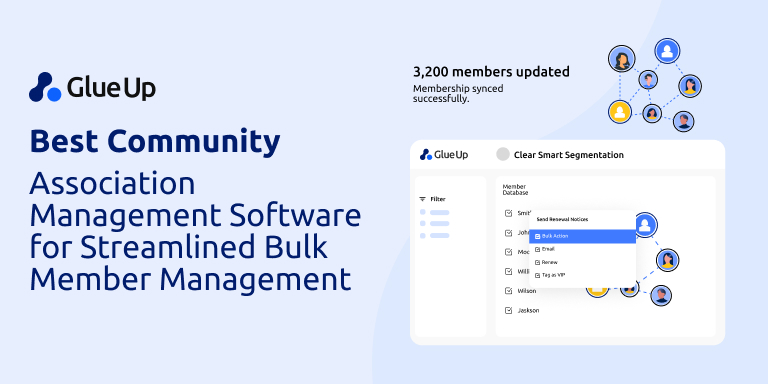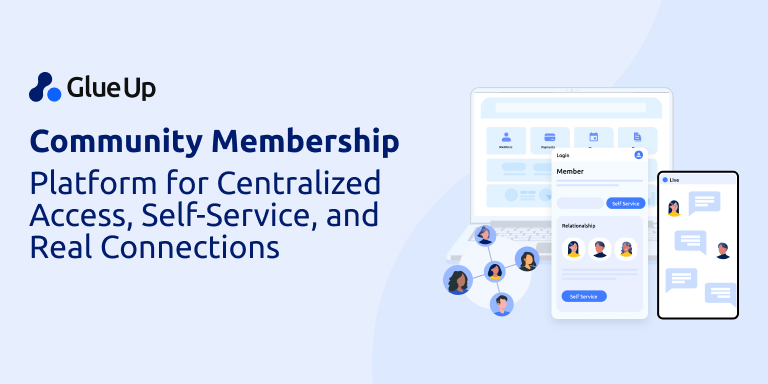![A Comprehensive Guide to Building an Online Community [With Steps, Best Practices, and FAQs] A Comprehensive Guide to Building an Online Community [With Steps, Best Practices, and FAQs]](/sites/default/files/2023-05/online%20community%20for%20associations.webp)
Last Updated: January 19, 2024
As we delve into the digital era, online communities are emerging as a cornerstone in bringing individuals together, fostering interactive dialogue, and enhancing the overall experience for members associated with various organizations.
Moreover, these virtual communities present themselves as a powerful medium for mobilizing collective action and advocating for shared causes. This is particularly impactful for organizations focused on societal or ecological issues, where the unified voices of their members can be amplified through digital platforms.
In this comprehensive guide, we will discover the fundamentals, tools, and strategies for building an online community.
Key Takeaways
- Glue Up's new AI-powered community management platform represents a major innovation in how organizations can engage with and manage their communities.
- Using gated community platforms rather than social media groups allows for more control, privacy, and security. This creates a sense of exclusivity and belonging among members.
- Interactive elements like gamification with badges, leaderboards, and points make community experience more engaging and rewarding.
- A dedicated community moderator or virtual assistant can handle moderation, engage with members, analyze data, and manage administrative tasks.
- It takes time to build an engaged community, but the long-term benefits for member retention and relationships are worthwhile.
- Choosing software that aligns with your specific community goals is important. Decide whether your goal is to facilitate networking and knowledge sharing, or to provide support and answer questions.
What is an Online Community?

Online communities are virtual spaces made for people to interact, share information, and engage in discussions. These communities are formed around a shared interest, hobby, or cause, and they serve as a platform for people to connect, share information, and collaborate.
Digital communities serve as a valuable platform for organizations, providing an essential communication tool to reach out, engage with their members, and foster a strong sense of community.
Through these online platforms, organizations are now able to gather insightful feedback, contributing significantly to their decision-making process. Members feel more valued as their opinions are sought and heard, resulting in increased member satisfaction and loyalty.
Why Online Communities are Important for Member-Based Organizations?
The emergence and growth of online communities have fundamentally changed the dynamics of the present-day social and institutional environments. These communities have transformed into an indispensable part of our lives, acting as a bridge between organizations and their members. As Charles Leadbeater mentions:
“You can go online now and find really thoughtful, in-depth, considered, well-informed communities around virtually any issue. If it's your issue, there are now new ways of mobilizing knowledge that weren't there before. There are real bodies of significant knowledge on the web that are valuable that we haven't done nearly enough with.”
- Charles Leadbeater, Co-founder of The System Innovation Initiative
This is the reason why most organizations are creating digital communities. Not only do they give them a better opportunity to connect with customers, but they also help them build brand loyalty by cultivating a sense of belonging.
Some other benefits of digital communities include:
- Members can communicate and exchange information seamlessly.
- Make it easy to exchange knowledge and skills.
- Increases participation and engagement.
- Provides chances for collaboration and networking.
- Offer encouragement and support to other members.
- Encourage members to express their ideas and concerns.
- Enable the development of a sense of collective identity and goal.
Different Types of Online Communities
Discussion forums, social media groups/pages, and professional networking sites are the three most popular types of online communities used by member-based organizations.
In order to make things simpler, we have defined each one separately. However, most of the online communities we see today are a combination of them.
Social Media Groups
Social media groups are the most common types of digital communities as they are easy to discover and engage with.
These groups enable organizations to share news and updates, promote events, and connect with members. In addition, they can be used to increase awareness about your organization and attract new members through effective social media posts.
However, one great disadvantage of social media groups is the vulnerability of data. Your members' information can be shared with third parties (including your competitors).
Read more: Glue Up Community vs. Conventional Social Media - Which One Drives More Community Engagement?
Discussion Forums

Discussion boards, also known as online forums or message boards, represent another type of digital community.
These virtual platforms are designed primarily for sharing information and provide a structured environment for members to post messages, ask questions, and respond to other users' posts.
However, unlike social media platforms, you cannot use them to share updates or promote your events.
Professional Networking Platforms
Professional networking platforms, such as LinkedIn, are specifically designed for building and maintaining professional connections. They focus on career development, job opportunities, industry news, and professional growth.
Their primary goal is to facilitate professional networking, personal branding, and business-oriented interactions. They provide virtual spaces for members to create profiles, connect with peers, build relationships, and exchange knowledge and information related to their respective fields.
How to Build an Online Community for Your Member Organization?
Step 1: Identify your Goals and Target Audience
Start by deciding the goal for your community. What is its purpose? Is it for information, social, or commercial purposes?
Also, take into account the target demographic or the ideal member profile (ICP) you want to draw to your community.
Step 2: Select a Platform that Supports Your Community's Goals
Choosing the right platform for your community is crucial in aligning with your community's goals and ensuring a seamless user experience.
Evaluate various platforms based on their features, scalability, customization options, and integration capabilities.
Consider the specific needs of your community, such as discussion forums, file sharing, event management, or multimedia support, and opt for a community platform that offers the necessary tools to fulfill those requirements.
Step 3: Invite your Members to Join Your Community
Foster engagement and growth by extending personal invitations and encouraging members to join your vibrant community.
Create compelling messages that showcase the benefits and opportunities they have to look forward to, igniting their enthusiasm and curiosity. Facilitate seamless registration processes and make it easy for them to join your thriving community.
Step 4: Publish Content and Updates
Produce relevant and educational content that aligns with the community's goals and appeals to its users. Consider incorporating visual elements like photos, videos, and infographics to make your content more engaging.
Read more: Maximizing User-Generated Content for Community Building
Step 5: Encourage Interaction and Participation

Ask questions, solicit feedback, and create polls to encourage community members to interact and participate in discussions. Encourage participation by offering badges, promotions, or other rewards.
Step 6: Moderate and Manage Your Community
Moderation and management are critical as your community grows.
Establish clear behavioral guidelines, consistently enforce them, and respond quickly to inappropriate behavior. Maintain a positive community culture by engaging with members on a regular basis.
Find out what the industry leaders have to say about community management in this blog.
Common Challenges in Online Community Management
1. Lack of Engagement and Participation
Encouraging members to participate and engage in the community can be difficult.
One reason for low engagement could be a lack of time or interest. For example, members may have hectic schedules or limited time to participate in community activities. Furthermore, members may be unfamiliar with the platform, making it difficult to navigate and participate.
Organizations can employ various strategies to address these issues, including providing member incentives, exclusive content and benefits, cultivating a welcoming and inclusive community culture, and investing in effective moderation and conflict resolution processes.
Read more: 8 Ways to Use Content to Acquire and Engage Your Members
2. Dealing with Sensitive Topics
Anything that elicits an emotional response from community members qualifies as a sensitive topic. Religion, politics, race, gender, sexuality, and other topics are all possible.
Dealing with sensitive topics in online community management necessitates extreme caution and attention, as mishandling such discussions can result in negative consequences such as hurt feelings, loss of trust, and even community members leaving.
Establishing clear rules and guidelines for discussion is the first step in dealing with sensitive topics in online community management. There should be no hate speech, personal attacks, or discrimination in the rules.
3. Trolling and Negative Comments

Trolling is another significant challenge that you may face when managing online communities. Trolling results in offensive, off-topic, or inappropriate messages or comments deliberately to provoke other members or disrupt the discussion.
Trolling management necessitates a proactive and multifaceted approach that includes both technical and social interventions. The most effective way to control trolls is to implement moderation policies and guidelines, provide tools for reporting inappropriate behavior, and provide clear consequences for trolling behavior.
4. Balancing Freedom of Expression and Moderation
One of the toughest aspects of managing an online community is striking the right balance between freedom of expression and moderation. Of course, freedom of expression is a fundamental right.
However, defining acceptable speech and behavior in a community can be difficult. Some members, for example, may regard specific topics or language as harmless, whereas others may find them offensive or triggering.
To address this issue, community managers must establish clear guidelines and rules for community behavior. These policies should be transparent, easily accessible, and updated regularly to reflect changing community standards and expectations.
5. Maintaining Community Standards
Ensuring that community members follow the rules and guidelines can be difficult. However, it is critical to have clear and concise community standards to ensure members understand what behavior is and is unacceptable.
Make sure you implement a moderation policy that outlines the consequences of violating community guidelines, train moderators to handle different situations, and provide a platform for members to report inappropriate behavior to maintain community standards effectively.
Best Practices for Successful Digital Community Building
Given below are three best practices you should consider for building a successful digital community.
However, if you're looking for best practices in community management and moderation, please read this article.
Use a Gated Community Platform
While social media groups have their merits in terms of reach and accessibility, gated communities like Glue Up offer more control, and privacy allowing you to build tailored and valuable communities.
They also foster a sense of exclusivity and belonging among your members. They create a member-only space for them which strengthens the feeling of security and builds stronger relationships among participants.
This exclusivity encourages them to engage more actively, as they perceive the community as a privileged space for networking, collaboration, and knowledge-sharing.
Leverage AI for Community Building
Artificial intelligence (AI) is transforming how organizations manage and engage with online communities.
Leveraging AI for community building can help you gain valuable insights into community health and member needs. Additionally, you can use these AI tools to get personalized recommendations and relevant content to drive participation.
This ensures that your members feel understood and valued, fostering a stronger sense of belonging and increased engagement within the community.
Glue Up has taken an innovative leap by introducing the first global AI-based community management cloud. This cutting-edge platform is designed to help organizations achieve new heights of engagement and efficiency in their community interactions.
The AI-powered feature of Glue Up acts as an intelligent writing assistant, capable of generating captivating event titles, subtitles, SEO descriptions, summaries, survey descriptions, and campaign text blocks with ease.
By inputting the specifics of a project, the AI Copilot crafts content that is tailored to the unique needs of the community, which can then be refined or dismissed as per the organizer's preference. This AI-driven methodology enhances the efficiency of community management significantly, transforming the dynamics of how organizations interact and connect with their members.
If you want to know more about Glue Up AI Copilot and how it works, you can read this guide or get a demo to experience it first-hand.
Include Interactive Elements
Having the same news feed can make your community boring.
Try adding some interactive elements for boosting engagement. Implement gamification elements to make the community experience more enjoyable and rewarding. Introduce badges, leaderboards, or point systems to recognize and incentivize member contributions.
It will not only encourage active engagement but also add a friendly competitive element to encourage members to participate consistently.
Finally, you can also encourage them to share and engage with various forms of multimedia content, such as images, videos, and infographics.
Hire a Community Moderator

Keeping an online community thriving requires effective management. This can be a time taking process, especially with all the other tasks on your team's plate.
We recommend hiring a virtual assistant to monitor and engage with community members, handle administrative tasks, and analyze community data. This can free up your valuable time and resources to concentrate on more strategic tasks like improving member satisfaction and building relationships with them.
There are many platforms from where you can hire virtual assistants. However, make sure to hire someone with a significant similar experience to ensure effective community management.
Depending on the size of your community, you can also hire more than one moderator.
It takes time to build an online community, but the results are well worth the effort. And with the upcoming digital era of community-driven growth, it's essential to your organization's long-term success.
If you have more questions regarding building your online community, feel free to contact us here. You can also check out this page for some successful examples of associations establishing online communities.
FAQs
1. What are some top platforms for building an online community?
There are several popular platforms available for building an online community, each with different features, user experiences, and customization options. Make sure you list your specific needs, goals, and preferences before choosing one.
For example, if your primary goal is to help your members with queries, you can go with forums like Reddit or Quora. However, if you are looking for an all-rounder networking platform that encourages knowledge sharing as well as building relationships, we suggest you check out Glue Up community management software.
2. How do you build community engagement online?
The first step in fostering community engagement is to create an environment where members can freely interact and communicate.
Utilize interactive features such as polls, surveys, and challenges to encourage member involvement. Seek feedback and act upon it to improve the community experience.
Finally, create networking opportunities and organize online events to facilitate connections and collaboration among members.
3. What is the role of community leaders in the success of digital communities?
Community leaders help facilitate engagement and participation. They encourage users to produce useful, authentic content that increases interactions between members. This kind of user-generated content is linked to higher engagement and loyalty.
They also serve as sources of topic-setting and important language within subgroups. Their communications and connections have an outsized influence on community discussions and direction.
4. How does community management software enhance the learning experience for members?
Community management software enhances the learning experience by facilitating the development and delivery of online courses. These courses can cover a wide range of topics, including industry trends, professional development, and practical skills like leadership and communication.
The flexibility of these platforms allows for personalized learning experiences, keeping members engaged and providing them with relevant knowledge and skills.



